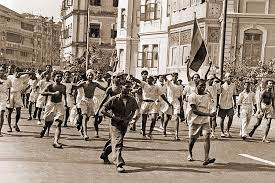The Naval Mutiny of 1946:
In the annals of India’s struggle for independence, a pivotal moment emerged in 1946 that hastened the departure of British colonial rule.

The Gateway of India, an iconic monument on Mumbai’s shoreline, and the opulent Taj Hotel, which stands proudly in its vicinity, narrowly escaped destruction in a historic episode known as the Naval Mutiny of 1946.
Discontentment among Soldiers Of Naval Mutiny:
The stage was set on February 18, 1946, when discontentment among Indian sailors in the British Indian Navy reached its boiling point. The Royal Indian Navy – Naval mutiny enduring substandard rations, decided they could tolerate it no longer. The breaking point was the meager breakfast of ‘daal’ and ‘double roti,’ followed by a repetitive lunch of rice and the same ‘daal.’
Naval Mutiny: Rebellion’s epicenter
The rebellion’s epicenter was the communication training center near the Bombay port, aboard the HMIS Talwar. The frustrated mariners chanted the slogan, “No food, no work,” boldly rejecting the orders of their British officers. The initial cause might seem trivial, but it ignited a fierce spark of rebellion. The simmering discontent found expression in punctured tires and slogans on the car of Commander Arthur Frederick King, as the sailors proclaimed “Gandhi’s Quit India” and “Netaji’s Jai Hind.”

Minor trigger amplified:
This seemingly minor trigger was amplified by the backdrop of ongoing trials against senior officers of the Azad Hind Army at Delhi’s Red Fort. The accused officers, Major General Shahnawaz Khan, Colonel Prem Sehgal, and Colonel Gurbaksh Dhillon, faced charges of waging war against the British Crown – the infamous Red Fort Trials.
Naval Mutiny gained momentum
As days unfolded, the mutiny gained momentum. By February 19, a staggering 20,000 sailors across all 11 naval units in Bombay joined the cause.
Confrontations between the rebellious Indian mariners and British soldiers escalated, punctuated by gunfire. The rebels captured 22 ships in Bombay’s vicinity, responding to British intimidation with a defiant show of strength.
Mutineers turned captured warship
In a move of strategic defiance, the mutineers turned captured warship cannons towards the Gateway of India and the Taj Hotel. Their message was clear: any harm to them would result in the destruction of these iconic landmarks.

Rebels’ strike announcement
The hub of the uprising, HMIS Talwar, housed more than just resentment. It operated as a radio station, broadcasting the rebels’ strike announcement. Swiftly, the message reverberated across naval camps, uniting over 20,000 individuals, 78 warships, and 23 naval stations by February 20. The rebellion’s impact extended beyond Bombay – mutiny surfaced in Karachi and Calcutta, echoing the sailors’ refusal to obey British orders.
Streets in South Bombay echoed with “British Quit India” slogans as Indian marines rallied the populace. The heart of the uprising was Azad Maidan, becoming a nexus for defiant meetings. The streets overflowed with more than 200,000 people, painting a vivid picture of collective determination.
The Naval Mutiny of 1946 shook the very foundation of British authority, setting the wheels of change in motion. With the Gateway of India and the Taj Hotel narrowly spared, the mutiny’s significance reverberated far beyond its immediate context. Ultimately, this uprising, driven by basic demands for fairness and dignity, became a decisive chapter on India’s journey to independence.
British deployed their formidable might
In a desperate bid to quell the uprising, the British deployed their formidable might. Tragically, between February 19 and February 24, the streets of Colaba and South Bombay became scenes of bloodshed, as the English army and police ruthlessly gunned down 400 individuals, with over 1500 sustaining injuries, in a ruthless effort to crush the rebellion.
Mill workers of Bombay rallied
According to Commander Dr. Johnson Odakkal, a retired director of the Maritime History Society and author of ‘Timeless Weight,’ the mill workers of Bombay rallied wholeheartedly behind the rebellion.

This collective support meant that a significant portion of the casualties – most of the 400 killed – were from Bombay.
Cambridge University the driving force
While the rebellion ignited on February 18, 1946, its underlying spark had been smoldering since February 2, 1946. BC Dutt, a key figure in leading the uprising, revealed in an interview with Cambridge University the driving force behind their actions. Their shared goal was to secure the release of soldiers who had served alongside Netaji Subhash Chandra Bose. These soldiers, Dutt emphasized, embodied the spirit of “revolutionary action” and patriotism, much like the rebels themselves.
Bold actions did not go unnoticed
As the movement gained momentum, posters bearing powerful slogans like ‘Quit India’ and ‘Jai Hind’ were affixed to the wooden steps leading to HMIS Talwar on the morning of February 2, 1946. However, their bold actions did not go unnoticed. The authorities apprehended them, and by February 8, 1946, Dutt and his comrades found themselves facing court martial after being caught with Gond, a traditional adhesive substance.
This series of events underscores the fervor and unity that fueled the rebellion, revealing a complex tapestry of individuals from various walks of life coming together with a shared vision of liberating India from the shackles of British colonialism.
For more news on Politics please visit – https://universenews.co.in/category/politics/
Pics Courtesy: Google
